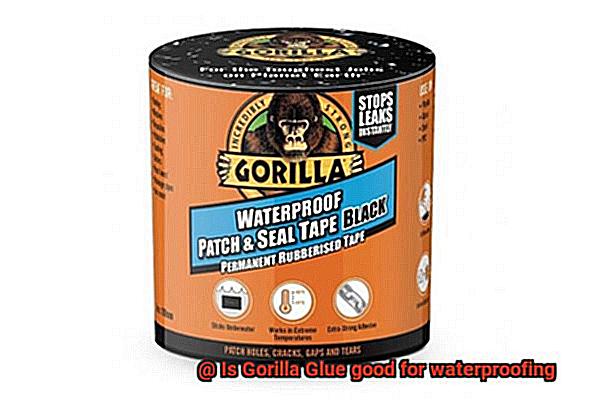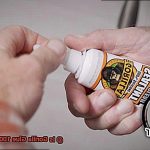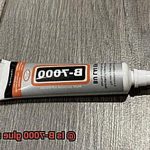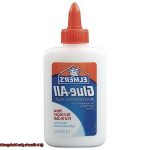Are you tired of searching for the perfect waterproofing solution for your next DIY project? With so many products on the market, it can be overwhelming to make a choice. But fear not, because Gorilla Glue might just be the answer you’re looking for.
Gorilla Glue is a heavy-duty adhesive that can bond to almost anything, making it a popular choice among DIY enthusiasts and professionals alike. But what sets Gorilla Glue apart from other adhesives is its ability to withstand exposure to water and moisture. That’s right – Gorilla Glue is an excellent option for waterproofing various materials.
In this blog post, we’ll dive into why Gorilla Glue is such a great choice for waterproofing. We’ll explore its unique features and how it works, as well as what types of materials it can bond to. Plus, we’ll share some tips on how to use Gorilla Glue correctly for optimal waterproofing results.
Whether you’re working on an outdoor project or need a reliable waterproofing solution for indoor use, Gorilla Glue has got you covered. So sit tight and let us guide you through everything you need to know about using Gorilla Glue for waterproofing.
What is Gorilla Glue?
Contents
- 1 What is Gorilla Glue?
- 2 Benefits of Using Gorilla Glue for Waterproofing
- 3 Potential Drawbacks of Using Gorilla Glue for Waterproofing
- 4 How to Properly Use Gorilla Glue for Waterproofing
- 5 Pros and Cons of Using Gorilla Glue for Waterproofing
- 6 Alternatives to Using Gorilla Glue for Waterproofing
- 7 Conclusion
This polyurethane-based adhesive is a game-changer when it comes to waterproofing.
First introduced to the market in 1999, Gorilla Glue has since become a household name known for its ability to bond almost any material, including wood, metal, ceramic, and many plastics. But what really sets it apart is its ability to seal and bond surfaces together, making it ideal for waterproofing. Say goodbye to leaky gutters, pipes, and outdoor furniture – Gorilla Glue has got you covered.
What’s special about Gorilla Glue is its unique formula that requires moisture to activate the curing process. When applied to a surface, it absorbs moisture from the air and begins to expand, filling any gaps or holes in the material. And once it’s cured, it’s waterproof and won’t lose its bonding strength even in wet environments.
It’s important to note that while Gorilla Glue can seal small leaks, it may not be suitable for larger or more complex plumbing issues. And as with any adhesive, it’s important to follow the manufacturer’s instructions for best results.
Another thing to keep in mind is that Gorilla Glue dries to a light tan color which may not be ideal for certain applications where appearance is important. However, it can easily be sanded or painted over once it has cured.
Benefits of Using Gorilla Glue for Waterproofing
Look no further than Gorilla Glue for a reliable, long-lasting solution. This high-strength adhesive is not only versatile enough to work on a variety of surfaces like wood, metal, plastic, and ceramic, but it also offers exceptional waterproofing capabilities.
One of the significant advantages of Gorilla Glue for waterproofing is its outstanding durability. This polyurethane-based adhesive creates a strong bond that can withstand water and moisture, making it perfect for repairing boats and other watercraft. Plus, it’s incredibly versatile and can be used in various applications where waterproofing is necessary.
Another great benefit is that this glue dries quickly, significantly reducing wait time before using the object you’ve waterproofed. Additionally, it’s resistant to temperature changes, ensuring its bond remains intact even when exposed to extreme temperatures.
Lastly, Gorilla Glue is also UV resistant, making it an ideal choice for outdoor projects that require waterproofing. It won’t break down or become brittle when exposed to sunlight, ensuring the bond remains strong and reliable for years to come.
Potential Drawbacks of Using Gorilla Glue for Waterproofing
While this popular adhesive offers some great benefits, there are a few potential drawbacks to consider before you start.
One issue to keep in mind is that Gorilla Glue can break down over time when exposed to prolonged moisture. This means that it may not be the most suitable option for surfaces that will be constantly exposed to water, such as in outdoor or marine environments.
Another potential problem is the glue’s tendency to expand as it dries. If you use too much, the excessive expansion may cause the glue to push away from the surface, creating gaps and holes that allow water to seep in. But if you use too little, it may not provide adequate waterproofing.
Furthermore, Gorilla Glue’s strong adhesive properties can make it difficult to remove or replace surfaces in the future. This could be an issue if the waterproofing needs to be redone or repaired.
Lastly, while Gorilla Glue is a powerful adhesive, it can be a bit tricky to work with. The glue requires moisture to activate and can be messy if not applied carefully. It also needs to be clamped or held in place until it dries completely, which can be time-consuming and inconvenient.
How to Properly Use Gorilla Glue for Waterproofing
Gorilla Glue is a powerful adhesive that is known for its bonding capabilities. However, did you know that it can also be used for waterproofing projects? If you want to ensure that your projects stay safe from water damage, Gorilla Glue may be the solution you’re looking for. Here are some helpful tips on how to properly use Gorilla Glue for waterproofing.
Apply Sparingly
One of the most important things to keep in mind when using Gorilla Glue for waterproofing is to apply it sparingly. Gorilla Glue expands as it dries, so using too much can cause the glue to bubble up and potentially compromise the waterproof seal. Instead, use a thin layer of glue and hold the surfaces together until the glue dries.
Prepare the Surface
Before applying Gorilla Glue, make sure that both surfaces are clean and dry. Any moisture or dirt on the surfaces can prevent the glue from bonding properly and may compromise the effectiveness of the waterproof seal. Remove any previous sealant or adhesive before applying Gorilla Glue for optimal results.
Consider Porous Surfaces
Gorilla Glue works best on porous surfaces like wood, stone, or ceramic. Non-porous surfaces like metal or plastic may require a different type of adhesive for optimal bonding and waterproofing. Keep this in mind when selecting your materials and adhesive.
Allow Time to Cure
To ensure a strong and lasting waterproof seal, give the glue at least 24 hours to fully cure before exposing it to water or moisture. This will allow the glue to fully expand and create a strong bond between the two surfaces.
Enjoy Your Waterproof Projects
By following these simple guidelines and taking care to apply the glue correctly, you can ensure that your projects are successfully sealed against water damage. Say goodbye to leaks and water damage and hello to successful waterproofing with Gorilla Glue.
Pros and Cons of Using Gorilla Glue for Waterproofing
Gorilla Glue is a well-known adhesive that can also be used for waterproofing. In this post, I’ll discuss the pros and cons of using Gorilla Glue for waterproofing, so you can make an informed decision on whether it’s suitable for your project.
Let’s begin with the pros. Gorilla Glue is a versatile adhesive that can bond to various surfaces such as wood, metal, ceramics, and more. It’s also waterproof, making it ideal for outdoor projects or areas prone to water damage. The glue’s strong bond can withstand pressure and vibrations, making it perfect for high-stress applications.

Another advantage of Gorilla Glue is that it dries clear. This makes it convenient for transparent surfaces where appearance is essential. Additionally, Gorilla Glue has a fast-drying time, which can be helpful in time-sensitive or emergency projects.
Now let’s talk about the cons. One disadvantage of Gorilla Glue is that it can expand as it dries. This expansion may cause the glue to foam and create a mess if not applied correctly. While this expansion can be beneficial in some cases, it’s essential to use the glue sparingly and follow the manufacturer’s instructions carefully.
Another point to consider is that Gorilla Glue requires moisture to activate the bonding process. Before applying the glue, surfaces must be dampened. If not done correctly, the glue may not bond properly.
It’s also worth noting that the strength of Gorilla Glue may weaken over time if exposed to sunlight or water for extended periods. This means that it may not be suitable for long-term outdoor projects without additional protection.
Lastly, Gorilla Glue is not suitable for all types of materials. For instance, it’s not recommended for use on polyethylene or polypropylene.
Alternatives to Using Gorilla Glue for Waterproofing
When it comes to waterproofing, many people often turn to Gorilla Glue for its strong adhesive properties. However, there are a few potential downsides to using this popular glue. One of the main issues is that it can be difficult to remove, making it challenging to make any necessary changes or repairs in the future. Moreover, Gorilla Glue may not be the best choice for certain materials like plastics or rubber.
Thankfully, there are several alternatives to Gorilla Glue that can be used for waterproofing. One of the most effective options is silicone sealant. This adhesive is specifically designed for bonding and sealing materials in damp or wet environments. Silicone sealant is suitable for a broad range of surfaces and is highly resistant to mold and mildew, making it perfect for bathroom renovations or outdoor projects.
Another strong and durable alternative is epoxy adhesive. This type of adhesive creates an incredibly robust bond that is resistant to water and other elements. While it can take longer to dry than other adhesives, epoxy adhesive is ideal for a wide variety of materials and projects. It requires mixing two components together before application.
For those who prefer natural alternatives, beeswax is an excellent option for waterproofing. Beeswax can be melted down and applied to surfaces such as canvas or leather to create a water-resistant barrier. It’s also eco-friendly since it’s biodegradable and non-toxic.
v9lVNMLz2FU” >
Also Read: Does Gorilla Glue Work On Fabric?
Conclusion
To sum it up, Gorilla Glue is a top-notch choice for waterproofing a variety of materials. Its one-of-a-kind formula requires moisture to activate the curing process, making it an ideal option for sealing and bonding surfaces together. With its ability to bond almost any material, including wood, metal, ceramic, and many plastics, the adhesive’s exceptional durability makes it perfect for repairing boats and other watercraft. Additionally, it dries quickly and can withstand temperature changes and UV rays with ease.
It’s worth noting that while Gorilla Glue is an excellent waterproofing solution, there are some potential downsides to using it. It may not be suitable for surfaces that will be constantly exposed to water or marine environments due to its tendency to break down over time when exposed to prolonged moisture. Moreover, if too much glue is used, it can expand as it dries or push away from the surface.
To make the most out of Gorilla Glue in your waterproofing projects, remember to apply it sparingly on clean and dry surfaces. Give it at least 24 hours to fully cure before exposing it to water or moisture.
If Gorilla Glue isn’t quite what you’re looking for in terms of waterproofing solutions, there are several alternatives like silicone sealant, epoxy adhesive or beeswax that you can consider.






